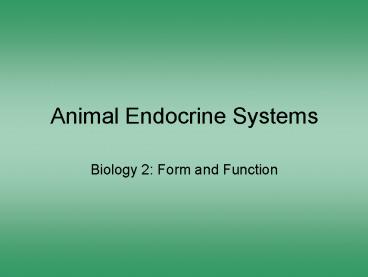Animal Endocrine Systems - PowerPoint PPT Presentation
1 / 28
Title:
Animal Endocrine Systems
Description:
Biology 2: Form and Function Hormones regulate... Together with nervous system, responsible for regulation of body organs Secreted by ductless glands into surrounding ... – PowerPoint PPT presentation
Number of Views:2262
Avg rating:3.0/5.0
Title: Animal Endocrine Systems
1
Animal Endocrine Systems
- Biology 2 Form and Function
2
Hormones regulate...
- Together with nervous system, responsible for
regulation of body organs - Secreted by ductless glands into surrounding
capillary network - Long-term, narrow-to-broad impact mediated by
contact of hormone with receptor molecules at
target site - Receptor molecules may be internal or external to
cell - Endocrine system is distinct to organ
self-regulation, or autocrine/paracrine system
3
(No Transcript)
4
There are four classes of hormone
- Polypeptides - short chains lt 100 amino acids in
sequence, e.g., ADH - Glycoproteins - long chains (100) of amino
acids connected to carbohydrate, e.g., FSH - Amines - derivatives of tyrosine and tryptophan,
e.g., epinephrine, thyroxine - Steroids - lipid derived
- sex steroids, e.g., testosterone
- corticosteroids, e.g., aldosterone
5
In mammals, there is a close association between
the endocrine and neural systems...
- Nervous system-controlled endocrine glands
include - Adrenal medulla
- Posterior and anterior pituitary (via
Hypothalamus) - Pineal gland
- Examples of non-nervous system controlled
endocrine secretion include pancreas (insulin),
and adrenal cortex (aldosterone)
6
(No Transcript)
7
Hormones that enter cells
- Includes all lipophilic (lipid-soluble) hormones
(e.g., steroids, thyroxine) - Bind to specific receptors in cytoplasm, which
then moves to the nucleus, or binds directly to
receptor proteins in nucleus - Receptor molecule, once activated, binds to
portions of DNA and stimulates transcription,
ultimately effecting protein production and cell
metabolism
8
(No Transcript)
9
(No Transcript)
10
(No Transcript)
11
Hormones that do not enter cells...
- Water soluble hormones that bind to the outside
of cell membranes, requiring a secondary
messenger inside cell to complete message - Secondary messengers include
- Cyclic AMP
- IP3/Ca2
12
Cyclic AMP
- e.g., effects of epinephrine on b-adrenergic
centers - Binding of epinephrine to G-protein receptor
causes G-protein sub-unit to disassociate - G-protein sub-unit binds with membrane enzyme
adenlyl cyclase - Adenlyl cyclase, now activated, catalyzes
formation of cAMP from ATP - cAMP binds to and activates protein kinase-A,
responsible for phosphorylation of certain
proteins specific to tissue/cell - in liver, stimulates conversion of glycogen to
glucose - In cardiac muscle, increases speed and force of
heart beat
13
(No Transcript)
14
Inositol triphosphate/Ca2
- e.g., effects of epinephrine on a-adrenergic
centers - Binding of epinephrine to G-protein receptor
causes G-protein sub-unit to disassociate - G-protein sub-unit binds with, and activates
membrane enzyme phospholipase C - Phospholipase C cleaves certain phospholipids to
produce IP3 - IP3 binds with receptors on endoplasmic
reticulum, stimulates release of Ca2 - Ca2 binds to calmodulin, which activates
different types of protein kinases, causing
phosphorylation of different cellular proteins
15
(No Transcript)
16
The Posterior Pituitary
- neurally derived hormones are part of
neuroendocrine reflex. - Secretes Antidiuretic hormone (ADH) and Oxytocin
(although both are made in the hypothalamus) - ADH stimulates water retention by the kidneys
(alcohol inhibits ADH, causing dehydration) - Oxytocin stimulates uterine contractions and
milk-ejection reflex
17
(No Transcript)
18
Anterior pituitary
- Epithelially-derived tissue, produces
- GH, growth hormone (somatotropin)
- ACTH, adrenocorticotropic hormone (corticotropin)
- TSH, thyroid stimulating hormone (thyrotropin)
- Gonadotropins LH (luteinizing hormone) and FSH
(follicle stimulating hormone) - Prolactin (PRL)
- MSH, Melanocyte-stimulating hormone
19
(No Transcript)
20
(No Transcript)
21
Control of the Anterior Pituitary by the
Hypothalamus is still hormone-mediated
- Releasing and inhibitory hormones are secreted by
the hypothalamus and carried via a c apillary
network connected to a second caillary network -
the hypothalamo-hypophyseal portal system - for example, gonadotropin releasing hormone
(GnRH) stimulates the release of FSH and LH - In turn, hypothalamus is controlled by negative
feedback inhibition
22
(No Transcript)
23
(No Transcript)
24
(No Transcript)
25
Other endocrine glands
- Adrenal glands
- The adrenal medulla secrets epinephrine and
norepinephrine, triggering alarm responses across
the body at various targets, preparing the body
for fight or flight - The adrenal cortex secretes cortisol and other
glucocorticoids, an aid in glucose homeostasis,
as well as aldosterone, responsible for salt
balance
26
(No Transcript)
27
The pancreas has both exocrine and endocrine
functions
28
(No Transcript)































